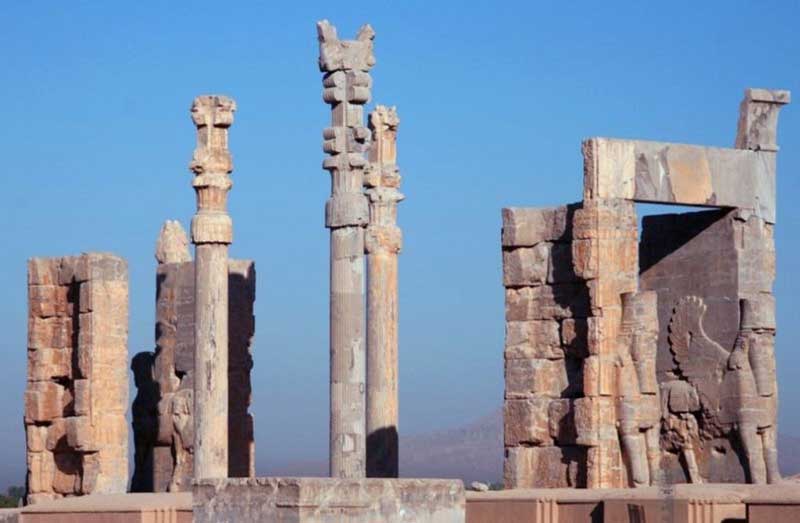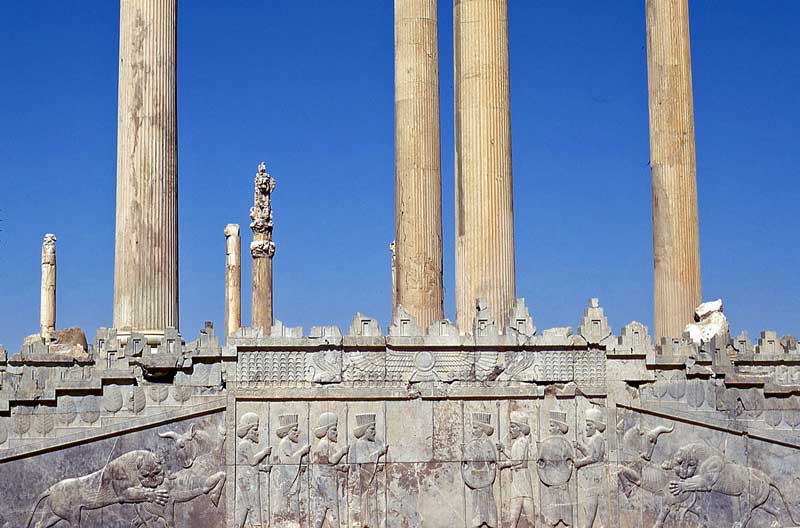
Situated 60 km northeast of the city of Shiraz in Iran, Persepolis was once the capital of the Achaemenid Empire. The English word Persepolis is derived from a couple of Greek words, Perses and Poils, which means the ‘Persian city’ or the city of Persians. A tiny river, called Pulvar flows by the site of Persepolis, which is marked by a large terrace of 125,000 sq m, which was partly constructed and partly cut out of a mountain, with its east side literally leaning on Kuh-e-Rahmet Mountain, also known as the Mount of Mercy.
The other three sides are formed by the mountain walls, which vary in height, with the slope of the ground from 13 to 41 feet (4 to 12 m).Large depressions were filled with soil and heavy rocks to create the level terrace which was then fastened together with metal clips and on this leveled ground the first palace at Persepolis slowly grew.

On the west side, it has a magnificent double stair in two flights, known as the Persopolitan stairway, construction of which begun around 515 BC. It consists of 111 short stone steps and leads to the top of the terrace, containing the ruins of a number of colossal buildings, all constructed of a dark gray stone. The steps of the stairway were so wide that the Persian royalty and the nobles could ascend or descend the stairs by horseback, without touching the ground with their feet. The top of the stairways led to a small yard in the north-eastern side of the terrace, opposite the Gate of all Nations.
Darius I made Persepolis the capital of Persia proper, replacing Pasargadae, the burial place of Cyrus the Great. However, as it was built in a remote and mountainous region, Persepolis was an inconvenient royal residence and the administration was carried out from the imperial cities of Susa, Babylon and Ecbatana. Alexander plundered the city in 330 BC and burned the palace of Xerxes. In 316 BC, Persepolis was still the capital of Persis, but only as a province of the Macedonian empire. Around that time, a devastating fire consumed the palaces or the palace of Persepolis. Gradually, the city started to decline under the Seleucid Kingdom. Around 200 BC, the city of Estskr, five kilometers north of Persepolis, was the seat of the local governors. At the time of the Muslim invasion Estakhr offered a desperate resistance. But, in the 10th century, its importance was speedily eclipsed by the new metropolis of Shiraz. During the following centuries, Estakhr gradually declined, until it became a ruin.

It is deemed that, the Achaemenid king Darius I (522-486 BC) was deeply inspired by the Mesopotamian models and started to build the splendid palatial complex on an immense half-natural, half-artificial terrace, which he could not complete. However, the project was continued by his son Xerxes I (486-465 BC) and his grandson Artaxerxes I (465-424 BC). During that period the huge project was completed, which included the Throne Hall, the Apadana, the Council Hall (Tripylon or the Triple Gate), as well as the main imperial Treasury and its surroundings. Further construction of the buildings on the terrace continued until the downfall of the Achaemenid Empire.
The ancient architects of Persepolis constructed lighter roofs with wooden lintels and used a minimal number of amazing slender columns to support the open area roofs. Grey limestone was used as the main building material. The ruins of Persepolis, which include among others, the terrace of Persepolis, the double flight of access stairs and its walls covered with sculpted friezes, the remains of the large halls and the massive gigantic winged bulls are considered as a unique archaeological site, for its importance and richness of quality of the monumental ruins.


The construction of the great palace of Persepolis on the western side was started by Darius the Great and completed by his son, Xerxes I, 30 years later. The palace consisted of a grand hall in the shape of a square with seventy columns, thirteen of which still stand on a massive platform. The tops of the 62 feet (19 m) tall columns were ornamented with animal sculptures, like two-headed bulls, lions and eagles. The great hall had two doors, one to the south, which opened to the Apadana yard and the other onto a winding road to the east. The presence of pivoting devices in the inner corners of all the doors indicate that they were two-leafed doors, probably made of wood and covered with sheets of ornate metal. The hall, known as the Apadana or the Audience hall was the largest building on the Terrace at Persepolis.

Located next to the Apadana, the Throne Hall, also called the Hundred-Column Hall, is the second largest building of the Persepolis Terrace. It was started by Xerxes and completed by his son Artaxerxes I, during the end of the fifth century BC. The hall had eight decorated stone doorways. The south and north doorways were ornamented with reliefs of throne scenes, while the east and west had scenes depicting the king in combat with monsters. The northern portico of the building was flanked by two colossal stone bulls. Initially, the hall was used mainly for receptions for representatives of all the subject nations of the empire. Later, as the Treasury faced a space problem, it also served as a storehouse.

The Hadish Palace, the palace of Xerxes, was twice as large as the Palace of Darius. However, compared to the palace of Darius, the house of Xerxes is badly damaged. The main room of the palace, consisting of thirty-six columns, was surrounded by six smaller rooms, three to the east and three to the west. It had a decorated portico on the north and the decoration was more or less identical to the palace of Darius.
The relatively unassuming mud-brick structure of the Treasury was situated on the southeastern corner of the main terrace in Persepolis. Surrounded on all four sides by streets and alleys, it had 100 rooms, halls, courtyards, and corridors in its final form. Probably, its doors were built of wood and the roof was supported by more than 300 columns. Some remnants of the vast stores left behind by Alexander were found in the Treasury, along with coins, glass, stone and metal vessels, metal weapons, and tools of different periods.

Apart from the above, the ruins of Persepolis also include the Tachara, the Council Hall, the Tryplion Hall, the Royal Stables, the Chariot House and numerous tombs.
Neglected for ages, Persepolis was buried under its own ruins till AD 1620, when it was first identified by the Europeans. Cornelis de Bruijn, a Dutch artist, published the first detailed description of the site in 1705. Strangely enough, no action was taken to excavate the remains of Persepolis till 1931, when Ernst Herzfeld, the then Professor of Oriental Archaeology in Berlin, was commissioned to undertake a scientific excavation of the spot.
The archaeological site of Persepolis was enlisted in the UNESCO World Heritage Site in 1979.